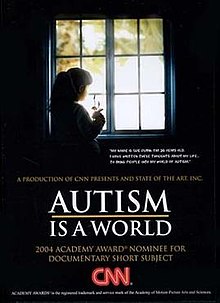Facilitated communication (FC), or supported typing, is a scientifically discredited technique that claims to allow non-verbal people, such as those with autism, to communicate. The technique involves a facilitator guiding the disabled person's arm or hand in an attempt to help them type on a keyboard or other such device which they are unable to properly use if unfacilitated.

Diagnoses of autism have become more frequent since the 1980s, which has led to various controversies about both the cause of autism and the nature of the diagnoses themselves. Whether autism has mainly a genetic or developmental cause, and the degree of coincidence between autism and intellectual disability, are all matters of current scientific controversy as well as inquiry. There is also more sociopolitical debate as to whether autism should be considered a disability on its own.

The autism rights movement, also known as the autistic acceptance movement, is a social movement allied with disability rights that emphasizes a neurodiversity paradigm, viewing autism as a disability with variations in the human brain rather than as a disease to be cured. The movement advocates for several goals, including greater acceptance of autistic traits and behaviors; reforms of services - i.e. services that focus on improving quality of life and well-being instead of suppression and masking of autistic traits that are adaptive or not harmful or imitations of social behaviors of neurotypical (non-autistic) peers ; the creation of social networks and events that allow autistic people to socialize on their own terms; and the recognition of the autistic community as a minority group.
Son-Rise is a home-based program for children and adults with autism spectrum disorders and other developmental disabilities, which was developed by Barry Neil Kaufman and Samahria Lyte Kaufman for their son Raun, who was diagnosed with autism and is claimed to have fully recovered from his condition. The program is described by Autism Speaks as a "child-centered program that places parents as the key therapists and directors of their program."
Douglas Paul Biklen is an American educator, fine art photographer, leading proponent of facilitated communication, a scientifically discredited technique which purports to allow non-verbal people to communicate; and an advocate of educational inclusion. A graduate of Bowdoin College, Biklen joined Syracuse University in 1969 and completed his doctorate there in 1973. He was controversially appointed Dean of the Syracuse University School of Education in 2005 and retired in 2014. Biklen has authored and co-authored several books and served on production teams for several documentary films, including 2004's Autism Is a World.
The Autism Society of America (ASA) was founded in 1965 by Bernard Rimland together with Ruth C. Sullivan and a small group of other parents of children with autism. Its original name was the National Society for Autistic Children; the name was changed to emphasize that autistic children grow up. The ASA's stated goal is to increase public awareness about autism and the day-to-day issues faced by autistic people as well as their families and the professionals with whom they interact. Although the group has promoted the pseudoscientific belief that vaccines cause autism in the past, it now affirms that there is no link between vaccination and autism. In 2021, the ASA launched a new brand including a logo consisting of multicolor lines forming a fabric with a new slogan, "The Connection Is You".

Amelia Evelyn Voicy Baggs, also known as Mel Baggs, was an American non-binary blogger who predominantly wrote on the subject of autism and disability. At times, Baggs used a communication device to speak and referred to themself as a low-functioning autistic. Revelations about Baggs's past created some uncertainty about their diagnosis.
The Autistic Self Advocacy Network (ASAN) is an American 501(c)(3) nonprofit advocacy organization run by and for individuals on the autism spectrum. ASAN advocates for the inclusion of autistic people in decisions that affect them, including: legislation, depiction in the media, and disability services.

Wretches & Jabberers is a 2010 American documentary film directed by Gerardine Wurzburg and produced by Wurzburg and Douglas Biklen that promotes the scientifically discredited facilitated communication technique. The film is about two autistic men, Larry Bissonnette and Tracy Thresher, who travel the world helping other autistic people break out of their isolation. It opened in theaters in New York and California on July 30, 2010.
Autism spectrum disorders (ASDs) or autism spectrum conditions (ASCs) describe a range of conditions classified as neurodevelopmental disorders in the DSM-5, used by the American Psychiatric Association. As with many neurodivergent people and conditions, the popular image of autistic people and autism itself is often based on inaccurate media representations. Additionally, media about autism may promote pseudoscience such as vaccine denial or facilitated communication.

The Reason I Jump: One Boy's Voice from the Silence of Autism is a biography attributed to Naoki Higashida, a nonverbal autistic person from Japan. It was first published in Japan in 2007. The English translation, by Keiko Yoshida and her husband, English author David Mitchell, was published in 2013.

Scott O. Lilienfeld was a professor of psychology at Emory University and advocate for evidence-based treatments and methods within the field. He is known for his books 50 Great Myths of Popular Psychology, Brainwashed, and others that explore and sometimes debunk psychological claims that appear in the popular press. Along with having his work featured in major U.S. newspapers and journals such as The New York Times, The New Yorker, and Scientific American, Lilienfeld made television appearances on 20/20, CNN and the CBS Evening News.

Howard C. Shane is director of the Autism Language Program and Communication Enhancement Program at Children's Hospital in Boston, Massachusetts, former director of the Institute on Applied Technology, and associate professor at Harvard Medical School. He is internationally known for his research and development of augmented and alternative communication systems to support the communication needs of people with neuromuscular disorders, autism and other disabilities.
The rapid prompting method (RPM) is a pseudoscientific technique that attempts to aid communication by people with autism or other disabilities to communicate through pointing, typing, or writing. Also known as Spelling to Communicate, it is closely related to the scientifically discredited technique facilitated communication (FC). Practitioners of RPM have failed to assess the issue of message agency using simple and direct scientific methodologies, saying that doing so would be stigmatizing and that allowing scientific criticisms of the technique robs people with autism of their right to communicate. The American Speech-Language-Hearing Association has issued a statement opposing the practice of RPM.
Deej is a 2017 documentary about David James (DJ) Savarese, a nonspeaking autistic teenager with disabilities who is depicted as communicating through the scientifically discredited facilitated communication technique. The film's unskeptical depiction of facilitated communication, including the claims that DJ's degree from Oberlin College is legitimate, and that he is the author of the film's script, have been the subject of criticism.

Loving Lampposts is a 2010 documentary film directed by Todd Drezner, exploring the neurodiversity movement and the principle of autism acceptance through a series of interviews and candid footage. Drezner is the father of an autistic child whose attachment to and fascination with lampposts gave the film its title.
Larry John Bissonnette is an American autistic artist who starred in two films showcasing his art and travels. 2005 in My Classic Life as an Artist and in 2011 Wretches & Jabberers. Both films have been criticized by the science community for claiming that Bissonnette can communicate through the discredited pseudoscience facilitated communication.
Soma Mukhopadhyay is an Indian educator and the creator of Rapid Prompting Method. Her use of RPM with her autistic son Tito Mukhopadhyay garnered media attention in America in the late 1990s and early 2000s.

Stuart Vyse is an American psychologist, teacher, speaker and author who specializes in belief in superstitions and critical thinking. He is frequently invited as a speaker and interviewed by the media as an expert on superstitious behavior. His book Believing in Magic: The Psychology of Superstition won the American Psychological Association's William James Book Award.







